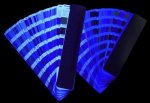gordo
Well-known member
Pantone is of course more interested in keeping their system LAB agnostic so that they can keep selling books with "Pantone 485" instead of everyone universally targeting the generic LAB coordinate of 49,67,53.
Imagine if medicine worked this way. We'd all be stuck buying Bayer Aspirin instead of acetylsalicylic acid.
I don't want to be an apologist for Pantone, however a recipe-based system is likely better than a Lab-based system. To use your medical analogy, when you go to your pharmasist to have your prescription filled, it is quite probable that they will use a recipe of base ingredients to create the final medicine that you buy.
A recipe based on qualified ingedients measured in parts, like Pantone colors, will likely be more accurate, and consistent than one based on Lab values which will when measured will vary from instument to instrument.
best, gordo














